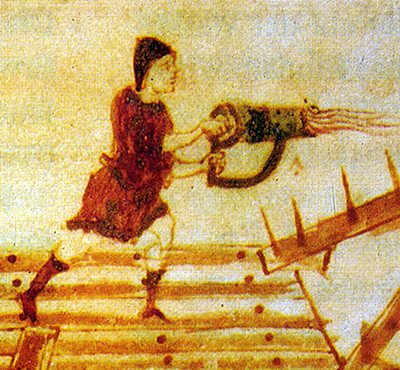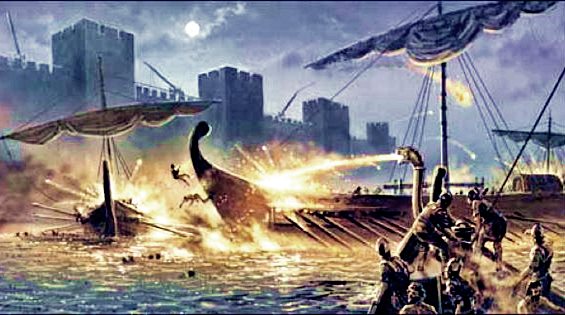
Siege of Constantinople (1st) |
year: 674-678 |
| The first unsuccessful siege of the Constantinople by the Arabs | ★ ★ ★ ★ ★ |
|
enemy: Arabs (Umayyads)
|
location: Constantinople
|
accuracy:
●●●●●
|
|
battle type: Siege |
war: Early Byzantine-Muslim Wars |
modern country:
Turkey |
| ▼ The Byzantines(emperor: Constantine IV) | ▼ The Enemies | |
| Commander: | Emperor Constantine IV | Various |
| Forces: | possibly around 40,000 | unknown but outnumbering Byzantines |
| Losses: |
| Background story: |
| In 661 the Arab civil war ended and Muawiya I emerged as caliph and ruler of the Muslim Arab empire. He was the founder and first caliph of the Umayyad Caliphate. The seat of the new caliph was no longer Medina, but Damascus in Syria. Not long after the end of the civil war, Muawiya broke the truce with Byzantium (which lasted just a few years). Almost from the beginning, it became obvious the his overall objective was the Byzantine capital, Constantinople. Starting in 662, Muslim armies began raiding and wintering on Byzantine soil west of the Taurus mountain, the Anatolian frontier. Since then, they were launching raids on an annual or bi-annual basis. These land expeditions were often coupled with naval raids against the coasts of southern Asia Minor. In spring 669, Fadala ibn Ubayd entered Asia Minor with a large army and advanced as far as Chalcedon, on the Asian shore of the Bosporus across from the Byzantine capital. The Arab attacks were repelled, and the Arab army was decimated by famine and disease. Muawiya dispatched another army, led by his son (and future Caliph) Yazid, to Fadala’s aid. The Arabs remained in Chalcedon for a while, and perhaps they tried an assault against Constantinople (this is not clear) but being unprepared for a lengthy campaign, they left returning to Syria. On their way, they captured and garrisoned Amorium, an important fortress-city. This was the first time the Arabs tried to hold a fortress in the interior of Asia Minor, beyond the campaigning season, and probably meant that they intended to use the fortress as a base for future campaigns; Amorium, however, was retaken by the Byzantines next winter. The campaign of 669 clearly showed to the Arabs the possibility of a direct strike at Constantinople, as well as the necessity of having a supply base in the region. This was found in the peninsula of Cyzicus on the southern shore of the Sea of Marmara. A raiding fleet under Fadhala ibn Ubayd captured Cyzicus and wintered there in 670 or 671. Cyzicus would serve as a key naval base of the Arabs in the following years during the escalation of the operations against Constantinople. Muawiya now began preparing his final moves. In contrast to the Chalcedon expedition, his plan was to take a coastal route to Constantinople. The undertaking followed a methodical, phased approach: first the Muslims had to secure bases along the coast, and then, with Cyzicus as a base, Constantinople would be blockaded by land and sea and cut off from the hinterland that supplied its food. Accordingly, in 672 three great Muslim fleets were dispatched to secure the sea lanes and establish bases between Syria and the Aegean. Muhammad ibn Abdallah's fleet captured Smyrna, another fleet wintered in Lycia and Cilicia, and a third fleet, joined them later. In 673, another Arab fleet captured Tarsus in Cilicia, as well as Rhodes. The latter, halfway between Syria and Constantinople, was converted for a few years into a supply base and center for Muslim naval raids.  Just prior to the siege, a Greek refugee from Syria named Kallinikos (Callinicus) of Heliopolis had invented for the Byzantine Empire a devastating new weapon that came to be known as the “Greek fire”. |
The Battle: |
 siege of 674-678 As Gibbon put it: “46 years after the flight of Mahomet from Mecca, his disciples appeared in arms under the walls of Constantinople. They were animated by a genuine or fictitious saying of the prophet, that, to the first army which besieged the city of the Caesars, their sins were forgiven: the long series of Roman triumphs would be meritoriously transferred to the conquerors of New Rome; and the wealth of nations was deposited in this well-chosen seat of royalty and commerce.” The Arab invasion force landed in April 674 on the Thracian shore in the district Hebdomon which was located outside the walls. Until September, there were constant clashes with the Byzantine troops and constant attacks against the walls. Apparently, the Arabs were not very well prepared for this operation. Their fairly lightly armed army and fleet did not have so much chance to break into this grandiose fortress defended by a system of massive walls and the sea. Constantinople was not under a serious threat to be captured at that siege. The big problem was the blockade of the city that lasted for 7 years (counting the earlier campaigns as well). According to Theophanes, in the first year, “Every day there was a battle from morning until evening, between the outworks of the Golden Gate and the Kyklobion, with attacks and counter-attacks”. After September, the Arabs departed and made for Cyzicus, 80 miles from Constantinople, to spend the winter. This set the pattern that continued throughout the siege: each spring, the Arabs crossed the Marmara and assaulted Constantinople, withdrawing for the winter to Cyzicus, in which they had established their magazine of spoil and provisions. This went on for 5 years. The winter withdrawals of the enemy fleet gave the Byzantines the precious opportunity to replenish their supplies and repair the city walls that had been partly damaged by the enemy. In fact, this siege of Constantinople was a series of engagements around the city with various Muslims forces coming and going. It is not known who was the commander of the Arab forces. According to Muslim sources, several important personalities of early Islam are reported as taking part. But we don’t really know who was the leader. The firm and effectual resistance by the Byzantines discouraged the Arabs that were used to quick victories with fast moving cavalry tactics. Arab fighters joined the siege looking for fast loot and slaves. Their leadership needed to keep the troops happy and diverted their arms to the more easy attempt of plundering the European and Asiatic coasts of the Propontis. But each year had seen a gradual abatement of Arab morale and vigor. In autumn 677 or early 678, after 4 years of siege, Constantine IV resolved to confront the Arab besiegers in a head-on engagement. His fleet was now ready to make use of the new weapon, the “Greek fire”. The Arab ships were almost all destroyed. The naval victory ensured that Constantinople could be re-supplied by sea. Meanwhile, the Arab forces were beset with starvation in winter. The Arabs were able to replace the lost ships, but after some more defeats, they finally broke camp in 678, ending 5 years of fruitless siege, and returned home. |
Noteworthy: |
| This is the first known use of Greek fire in combat. |
Aftermath: |
| It was the first of several times that the walls of Constantinople saved Byzantium and the western world from invading Muslims. For the Arabs, it was their first serious failure after many years of conquests. In 679 Muawiya sued for peace and agreed to pay an annual tribute of 50 horses, 50 slaves and 3000 golden coins. |
|
|
